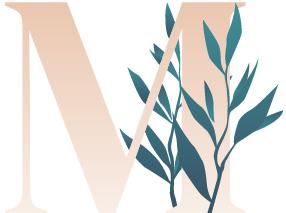Walking At Night
There is a distinct difference in feelings of safety between American and Swedish women when walking at night.
PAGE 2
When You Look At Me
A poem about existing in a body larger than what society deems acceptable.
PAGE 4
Mahsa Amini Riots
Though the Iranian government tried to imply Amini had underlying conditions that led to a heart attack, her family emphasized she had no health problems.
PAGE 6
Studying Abroad
Two worlds collide when studying in a completely new cultural environment.
PAGE 8
WMC Staff Reviews
Alice Osmen’s books are relatable to many audiences and dive into diverse topic mattters.
PAGE 13
Women Mentoring Women
Women make up almost half the labor force in the United States and are currently holding more leadership positions than in the past. However, according to Mckinsey & Company, for every 100 men promoted, 87 women are promoted. This statistic highlights how women, especially women of color, still experience inequality in the labor force, including, but not limited to, occupational segregation, pay gaps and sexism. In addition, these risk factors have been shown to impact mental health, with women being twice as likely to experience depression than men, as reported by the American Psychiatric Association. Women face distinct challenges while working in the labor force compared to men.
Mentoring can help women’s mental health for a variety of reasons. Mentors can help women navigate injustices in the workplace through empowerment, advancement and stress reduction. In addition, a mentor can help access employment and financial opportunities that otherwise would be missed. Furthermore, mentoring can provide a sense of social belonging and comradery with other women in the field, especially in male-dominated industries. Women who see other
women in their field, especially women in leadership positions, have shown a positive outlook and may consider taking a leadership role in the future. In addition, researchers have indicated that women mentors can help increase representation throughout various work settings, which can positively impact companies. It’s clear from the research that mentorship is beneficial mentally and professionally, but how does one find a mentor?

First, consider experts in your field. Professors are often open to mentoring and helping students in various capacities in educational settings. If you are exploring or have a set career path, find a professor that aligns with your future goals and notify them that you are interested in being mentored. Students can look up potential mentors by going to a university department’s webpage and identifying professors aligned with future goals through their Curriculum Vitae (CV) or biography. Consider current and previous professors you have had classes with that may have helped with your career goals.
Examine previous connections and networks. More companies and agencies are discovering the benefits of mentorship. As a result, some companies have established mentorship programs; all you need to do is apply. Ask your employer about a mentorship program within your company and how to enroll. Consider LinkedIn and other social media platforms to identify possible mentors. Think about women you may admire or look up to.
WOMEN MENTORING continues on page 14
Volume XXIX, Issue 2 1 Volume XXIX, Issue 2 THE WOMEN’S CENTER JOURNAL Inside This Issue: The Tennessee Tech University Women’s Center and Commission on the Status of Women
“Women helping each other–coaching, mentoring, and providing tips–is a great way for us to be our own force” – Indra Nooyi
Dessie Avila
Skriv Nar Du Kommer Hem
(Write When You Get Home): Walking Home at Night in Sweden vs. U.S.
Savannah Hunter
When I was studying abroad in Sweden, I did not realize that I would be walking home alone as much as I did. Whenever I did, I was petrified. The first time I walked home, I made sure I held my keys in between my fingers, stayed aware of my surroundings and walked with a purpose. I felt that I was bringing the knowledge from what I know back home in the U.S. with me to Sweden. However, whenever I brought this feeling and precautions up to my Swedish friends about walking home alone, they looked at me puzzled. They could not fathom why I would be so afraid to walk home alone. While speaking to my friend Linda Freiholtz (she/her), a resident of Sweden, she stated that she feels somewhat safe while walking home at night in Sweden but is still aware of her surroundings. She told me that, “In Sweden, it is illegal to carry weapons on you, so you can only use what is on you as self-defense: your body or phone.” I then explain the pressing obstacles that women face at night in the U.S. I stated that women are targeted for violent crimes at night such as, rape, robbery and homicide. Therefore, taking precautions are crucial for women while walking home at night.

Curious about these different perspectives, I decided to look at the statistical differences between Sweden and the United States. According to the OCED Better Life Index, six per 100,000 people are murdered while walking at night in the U.S., while the rate in Sweden is 1.1 per 100,000 people. Sweden is lower than the average 2.6 per 100,000 reported by the OCED Better Life Index. My Swedish friends told me that these fears are not common in Sweden. They feel relatively safe while walking home at night; they are aware of their surroundings but are not concerned that their life would be in danger while traveling home. This is because walking is common in Sweden and other European countries, and therefore, it is often overlooked to take precautions to be safe. Karlstad, which is where we lived, is an average-sized city with approx. 60,000
inhabitants. It is in a rural area of Sweden called Värmland. Regardless of its rural location, many Swedish inhabitants feel safe while walking home at night because there is less crime where they live in the middle of the city. According to Gallup News, 46% of women in the U.S. are fearful of walking home. According to Phys.com, only 24.9% of women in Sweden are fearful. This is an overall account of women in both urban rural areas in the U.S. and Sweden.
After comparing my experience and the statistics, it is

clear there are noticeable cultural differences between the two countries. In America, women are expected to be hyper aware of their surroundings and take precautions like placing their keys in between fingers, making sure they have pepper spray at the ready and be prepared to yell the right thing. In Sweden, no weapons are allowed on a person, so women must defend themselves with what’s on them. They are still aware of their surroundings, but since walking and public transportation are common, they stay to themselves. The Swedish culture is to stick to yourself and do not bother others. In America, we know it to be different. In America, because the effects of rape culture, women are forced to take the proper measure to protect themselves. Swedish culture suffers from elements of rape culture in their society; however, it may not be as visible because they live in an equality forward society. I wanted to express my experiences while living in Karlstad, Sweden and America and how I personally felt while walking home both while I was living internationally and domestically. I wanted to share pressing issues that women are faced with while walking home at night, and I hope this can put in perspective the drastic differences between the safety of women at night in America and Sweden.
References
Fitzegerald, Roge. (2021). Survey shows 32% of British women don’t feel safe walking alone at night – compared to just 13% of men. Phys Org. Norman, Jim.(2015). In U.S., Women, Poor, Urbanites Most Fearful of Walking Alone. Gallup. OECD Better Life Index.

Attune 2
Street in Stockholm from Savannah
They are aware of their surroundings, but are not concerned that their life would be in danger while traveling home.
Human Trafficking
Scott Moss
Human trafficking is modern-day slavery in which force, fraud or coercion is used to obtain some type of labor or commercial sex act. Worldwide, an estimated 27 million people are enslaved by traffickers, and more than 1.2 million children are trafficked for the purpose of being sold for sex.
Recent research has shown that while most people are aware of the existence of human trafficking, understanding the extent of the problem and its impact within our communities lags significantly. In Tennessee, for instance, 85% of the state’s counties (78 counties) have reported at least one case of human sex trafficking in the previous 24 months. Within that group, eight counties reported more than 100 cases during the measured period. It is difficult to accurately
rebranded this year as Ancora to better reflect the group’s emphasis on survivor services.



Kelli Cary, the chief executive officer of Ancora, says that as the single point of contact for human traffic referrals coming from the Tennessee Human Trafficking hotline, Ancora provides survivors with a comprehensive slate of aftercare services and connects them with other services throughout Tennessee.
if you suspect or witness human trafficking in your community.
report the number of human trafficking cases in Tennessee as there currently is no common reporting system or method to assess the number of victims.

Tennessee leads the nation in working to combat human trafficking. Ancora, a nonprofit organization based in Nashville, is a member of the Tennessee Counter-Trafficking Alliance (TCTA) and manages referrals for the 41 counties in Middle Tennessee. The organization began serving Middle Tennessee over 12 years ago as End Slavery Tennessee and
Cary says it is important for the public to recognize that trafficking occurs everywhere, including throughout Tennessee, and often does not look how the media portrays. “Trafficking takes place within the context of relationships,” Cary says, which means “most people know their traffickers and have a relationship with them.” Lastly, according to Cary, there is hope and a lot of amazing resources and organizations that are doing great work to combat trafficking.
Because today’s technologies can make this serious crime tricky to connect the offenders of human trafficking to their victims, it is important to educate others about the warning signs and realities of human trafficking and prostitution. Another way is to get involved by reporting
Signs that a victim is being trafficked can include being younger than what she or he claims, social isolation, being fearful of authority figures, inappropriate dress, malnourished and/or lacking in hygiene, carrying no personal belongings, identification or money and under the influence of drugs and/or alcohol. There may also be bruises, injuries or branding (with a tattoo) and always being accompanied by another person.
If you suspect someone you know is a victim of human trafficking you can call the National Human Trafficking hotline at: 1-888-373-7888. Help is available 24/7 and all reports are confidential. The Tennessee Human Trafficking Hotline can be reached at 1(855) 558-6484 or text “BeFree” to 233733.
Additional information on human trafficking and the services available for survivors can be found on the Ancora website at www.ancoratn.org.
References
Rapp-McCall, Lisa & Work, Robert & Lucio, Robert & Work, Frank & Orlando, M & Work,. (2021). Public Awareness and Knowledge of Human Trafficking: Results from a National Poll. 3. 14-36.
Telephone interview with Kelli Cary, 8 February 2023.

Volume XXIX, Issue 2
Ancora TN’s Logo
It is important for the public to recognize that trafficking occurs everywhere, including throughout Tennessee, and often does not look how the media portrays.
When You Look At Me
A Poem by Emily Alene
This is a work expressed in equal parts frustration and love. I have always existed in a body larger than what society deems to be acceptable. In recent years, I have done lots of internal work to confront my beliefs about myself and others who look like me. I have attempted to disentangle my naturally bubbly personality and colorful dress with the expectation of what a fat woman should look like, a task easier said than done. Mostly, I have worked to love myself as I am. It is through a genuine love and acceptance of myself that I am able to take joy in the body I live in, and I hope you can too.
Emily is a graduate student in accounting and has been previously published in The Iris Review.
When You Look at Me
How do you see me? You, at the beach?
In my bright pink swimsuit hugging my curves.
A one piece, only to protect my soft belly from cold ocean crashing not to shield your eyes from its beauty.
How do you see me?
With my double chin and wide hips and heavy breasts?
Do you see how smart I am or the number of books I read last year (69)



Do you see that I’m a wonderful conversationalist?

How do you see me?
With my thick thighs and chubby cheeks (of the face and otherwise)
Do you see my spirit which is even larger and more complex than the body it lives in?
4
Caged
Robin Pafford
“They wouldn’t treat you that way if you acted more modestly. Particularly when you’re choosing your outfit for the day.”

Cassidy Lawrence was a college student who had lately been plagued by an inappropriate professor and catcalling frat boys. Unsure of how to deal with these obstacles, she’d consulted the pastor at her church. After telling him how bad it’s been for her lately, he simply decided to blame it on her attitude and choice of clothing.
Cassidy sighed and, not wishing to prolong the uncomfortable conversation any longer, told him she had to get home. She didn’t know why she had bothered seeking out Brother Farris’s advice. No one ever saw her for who she really was. It was like she had invisible bars around her that prevented anyone from forming an accurate opinion. Did she play into these metaphorical bars? Certainly. But she didn’t want to. It was just what she’d learned she had to do in order to survive as a woman. It was a cage that she wanted to escape, but just didn’t know how to.
After arriving home, she saw that she had a couple of missed calls from her ex. She knew what he wanted. She didn’t really want the same, but she was feeling vulnerable and her day had been shitty. So she texted him a “come over,” and she went to her bathroom for a quick shower. She wasn’t on the pill, it was too much of a hassle. But she did always require him to wear a condom. In spite of finding the box to be empty when it was time to put the condom on, Cassidy reluctantly decided that it was too late to say no now.

The next day, she started looking up nearby Planned Parenthood places, making a backup plan for something that was now a serious possibility. With every passing minute, she was feeling more and more unsure about her possibly disastrous choice from the previous evening. After locating the closest one, she made her way to the kitchen to have her morning coffee.
Her phone started pinging like crazy once she’d sat down with her steaming cup. She turned her phone over in her hand to determine the cause of the ceaseless buzzing. What she read from the news app caused her to send her favorite lavender mug crashing to the floor, leaving a puddle of coffee-scented liquid encasing the shards. Cassidy hardly noticed the mess she had made; the news of Roe v. Wade being overturned had just
reached her.

Not only did she just have unprotected sex, but what if her professor and/or the catcallers soon decided to approach her in a way that she wouldn’t be able to stop? If she found herself with a positive pregnancy test a month from now, regardless of
how it came to be positive, she would no longer have the option of going to a Planned Parenthood. Her family would be so ashamed of her that she’d be as good as disowned. Her friends lived far away and had problems of their own to deal with. As far as her ex was concerned, he had “deadbeat dad” written all over him. She was alone.
Suddenly, she sees her cage growing to a size that makes her no longer able to make out the bars. The fantasy she had of once escaping is almost laughable. There’s no longer an exit in sight to even attempt to make her way to. This is her life now. Suffocated, shunned, caged.

Volume XXIX, Issue 2 5
What she read from the news app caused her to send her favorite lavender mug crashing to the floor, leaving a puddle of coffee-scented liquid encasing the shards. Cassidy hardly noticed the mess she had made; the news of Roe v. Wade being overturned had just reached her.
Mahsa Amini Riots




Mahsa Amini was a modestly mannered 22-year-old woman living in Iran, who met an untimely and “mysterious” death. On September 16, 2022, just 3 days after being arrested for breaching female dress code standards in Iran, Amini died in a hospital. Law enforcement of Iran insists that Amini had a heart attack while in police custody and subsequently collapsed into a coma. Other sources claim she had a brain seizure. Though the Iranian government tried to imply Amini had underlying conditions that led to a heart attack, her family emphasized she had no health problems. Eyewitnesses say otherwise in all cases, saying Amini was severely beaten by morality police before being arrested.
Some sources say a cerebral hemorrhage, or a brain bleed, is what killed Amini. In a letter from September 18, Doctor Hossein Karampour, the top medical official in Hormozgan province, pointed out that Amini’s symptoms “do not match the reasons given by some authorities who declared the cause to be a heart attack [but instead are consistent with] a head injury and the resulting bleeding.”
Amini was not a political activist. She has been described as “shy” and “reserved” by family members and was not trying to make a political statement by improperly wearing her hijab in public. Hadi Ghaemi, founder of the Center of Human Rights in Iran, expressed after Amini’s premature death, “Her face and her experience were very intimately and tangibly familiar to every family in Iran because every time their mothers, sisters,
and their daughters go out of the house, they have been harassed by the morality police, or detained or even beaten.” The tragic death of Mahsa Amini led to rioting and protesting, that opened the eyes of women all around the world to the gender inequality crises outside of the United States.
Starting the day of Amini’s death, riots began in Iran and have been monumental. Approximately 90,000 Iranians have protested discriminatory policies in their country, such as all women being legally obliged to wear a hijab in public. Violators of this rule face punishments that can include up to two months in prison, fines of up to 500,000 rials (Iranian currency) and be given up to 74 lashes on the back with a 3-foot whip. Of these brave protestors, 146 have been arrested, 1,160 have been non-fatally injured and 597 have died. These activists are demanding an end to mandatory hijabs and want wider freedoms and rights for women. The protests have led to workers going on strike and women are removing their headscarves, and citizens are not stopping. As of March 2023, the riots are still ongoing.
It is important to be aware of international events such as death of Mahsa Amini, not only because of the immorality of the situation and changes that need to be made, but also because as Americans, we often live in a privileged bubble. We focus so wholly on inconsequential things like division of political parties and differences in opinions; we overlook problems happening all around the world on which we all have the same stance. In this case, we as human beings can agree no one should die for what they wear, and no one should have to die for what they believe in, like many Amini rioters have. Often, we globally agree more than we disagree. We need to stand and unite more often, especially in matters of liberty and justice for all, all around the world.
Attune 6
Aislynn Martin
The tragic death of Mahsa Amini led to rioting and protesting, that opened the eyes of women all around the world to the gender inequality crises around the world.
Maternal Healthcare in India
 Rachel Flowers
Rachel Flowers
Maternal healthcare focuses on the health of the birthing parent during pregnancy, birth and the postnatal period that follows. Although childbirth is an experience that a lot of people go through, there are many differences when it comes to the access of safe healthcare around the world. India, in particular, has many different regions that can’t access safe and affordable healthcare for birthing parents or children.
India ranks 57 out of 184 in the world for the maternal mortality rate. Out of 100,000 live births, 145 mothers die during the birthing process, and there are 30.31 infant deaths per 1000 live births (India). In comparison, the U.S. has 21 maternal deaths per 100,000 births and Poland and Norway only have 2 maternal deaths per 100,000 births (Maternal Mortality Rate). The maternal mortality rate is a large concern for India with certain states experiencing even higher numbers of deaths. One large issue with maternal healthcare stems from economic issues, particularly those in rural and poorer areas of the country (Hamal, M. Et Al.).



The story of Manju, a women with a horrifying birth experience in Bihar, India, is one of many tragic birthing stories from this region. During the labor of her third child, Manju experienced excessive bleeding and had to be taken to the nearest hospital in a wheelbarrow since there was no access to an ambulance. When she was about a mile away from the hospital, she gave birth to her daughter on the side of the road. After the trauma of her experience, Manju became an Accredited Social Health Activist (ASHA). These activists have started initiatives that help expecting parents receive support, information, counseling and access to immunizations for their babies. Manju, and other ASHAs, are considered Frontline Health Workers (FHW) who travel to rural areas and provide maternal support for those in need. These FLWs are more connected to the rural parts of India, like Bihar, and they help offer information on hygiene, basic care and nutrition for parents and newborns.
Despite these workers decreasing the maternal mortality rate by nearly 50%, “Bihar has some of the country’s highest rates of maternal, neonatal, and infant mortality, as well as a high prevalence of malnutrition, stunted growth, and high fertility rates “ (CARE). There are still a lot of improvements that can be made to reduce maternal and infant mortality rates. These rural parts of India need significant changes in their maternal healthcare. One thing that would keep other stories like Manju’s from happening would be increasing access for emergency vehicles to reach these rural areas. I also think that recruiting more FLWs would continue to benefit the commu-
nity and spread valuable information to new parents. In the end, there are many other factors that affect the healthcare for these areas, but with these adjustments, the community could receive more medical support and lower the mortality rate.
This story focuses on the maternal healthcare in India specifically, but there are many countries that have severe maternal healthcare issues as well. More specifically, the U.S. has had alarmingly high rates of maternal and infant mortality, especially in communities with higher poverty and minority rates. Bringing awareness to issues like this in our communites is essential for change. Manju went through a traumatic and dangerous experience when she gave birth, and she knew that something had to change in her community so that nothng like this ever happened again. It is so important for us to notice the issues in our community and strive to make the change that will better peoples’ lives forever.
References
CARE. (2019, January 15). This woman’s traumatic birth ex perience inspired her to help other mothers in India. CARE. Hamal, M., Dieleman, M., De Brouwere, V. et al. Social deter minants of maternal health: a scoping review of factors influencing maternal mortality and maternal health ser vice use in India. Public Health Rev 41, 13 (2020). India. (n.d.). Cia.gov. Retrieved February 15, 2023. Maternal mortality ratio. (n.d.). Cia.gov. Retrieved April 3, 2023

Volume XXIX, Issue 2 7
Photo of Manju from CARE
Studying Abroad
When Two Worlds Collide
Interviews by Elizabeth Andrews
From the U.S. Grand Canyon to the Swedish Stockholm Cathedral and all the way to South Korea’s Changdeokgung Palace, Earth is a vast, diverse home to many different communities. Not one place is the same. Because of this, travelling is a passion many people around the world share. It is human nature to have a desire to see and learn about others and their cultures. In the United States, we are lucky to know and experience diversity, but we are isolated and ignorant of many other cultures. The study abroad program at Tennessee Tech aids students in their desire to see the world. I interviewed two students, one who studied abroad in the Fall 2022 semester in Europe, and one from abroad who is studying in Cookeville during the Spring 2023 semester.
wanted to travel. What she wanted to do most was “to see another part of the world and learn about different cultures.” Karlstad University in Sweden was her top choice because of their women and gender studies program.
Many people experience culture shock when traveling to an entirely new continent. When asked about these culture shocks, Savannah said that fashion and transportation were quite different. In America, college students often wear sweatshirts, leggings and workout clothing to class, but in Karlstad, everyone would dress up in high fashion just to go to the grocery store. When it comes to transportation in Sweden, Savannah added that “traveling over there and being in a town where I had no access to a car... was something extremely new to me” because people either walk everywhere or take public transportation. One of Savannah’s favorite places to walk to in Karlstad was Bunkern, a local student pub, where students would go and hang out in their free time.
Korea, many people are judged for how they look, dress and present themselves.

Before coming to America, YeonWoo had decided he wanted to experience as much of American culture as he could during his stay. Currently, he is a member of the Intercollegiate Equestrian Team, which is his favorite club on









Karlstad University, Sweden

Student Savannah Hunter (she/they) studied abroad Fall 2022 at Karlstad University in Karlstad, Sweden. She is from Kingsport, TN and is majoring in History with an emphasis on art history and ethnic studies. She is also in three different clubs, including the Peer Empowerment Program, College Democrats and the History Club. Savannah decided to study abroad because she has always
Student Yu YeonWoo (he/him) is from Seoul, South Korea, and he is currently studying business management here at Tech. There were few American programs through his specific university in South Korea, so Tennessee Tech was the only American school available to him. Despite this, he has found that Tech is a great school for him. One reason YeonWoo decided to travel to America was because he wanted to learn more English and experience the culture, since the two countries are quite culturally different. When asked about the biggest difference between the U.S. and South Korea he noticed so far, YeonWoo stated that “American people don’t judge other people.” According to YeonWoo, in
campus. One of his favorite places to go with his friends in Cookeville is Bee Rock Overlook, which reminds him of his favorite place to be back in Seoul. At home, YeonWoo loves to go to the Han River Bridge. He loves to look at the beautiful landscape that goes through the city and over the river, and he enjoys walking alongside it.
Both Savannah and YeonWoo have had amazing experiences when studying abroad. When embracing new cultures and flying halfway across the world, it can be scary to leave your home, but you can learn so much about people when you take a chance and jump right in! If you would like more information on how to study abroad, you can visit the study abroad office’s website at https:// www.tntech.edu/studyabroad/ or call them at 931-372-3659.
 Bee Rock Overlook in Cookeville, Tennessee
Bee Rock Overlook in Cookeville, Tennessee
Peaceful Easy Feeling
Parish
Another Albuquerque sunset. How many now? 55, 15 dozen, fitty-leven?
She stared silently at the subtly shifting shimmering sunlight as it moved across the topography beyond the sunbleached tarmac that was so markedly different from that of her lush green home state of Tennessee. “Fifth generation Nashvillian,” she used to say to the people she worked among and dwelled near and socialized with, in various cities in which she previously existed. Philly. Lexington. Atlanta. Orlando. Sacramento. Memories of those places and times not quite as sharp now, joy and pain in varying measures from each place, and the details of decades ago sometimes conflating with another time and another town and no longer holding as much weight in her mind as they once did.
“And I wanna sleep with you in the desert night with a billion stars all around.”



One of her favorite Eagles songs was playing intermittently, Glenn Frey’s sultry-smooth voice abruptly cutting out in between flight announcements and a stern admonishment that smoking and vaping were strictly prohibited in Albuquerque International Sunport. She drained the dregs of her nowcooled cup of stevia-sweetened Earl Grey, her established ritual upon departing the Land of Enchantment, and reflected on this visit. Is that right, calling them visits, though this strange and beautiful high desert place holds her heart? Leaving felt a little different this time, and she couldn’t attach a specific word to the feeling or a reason for it. Lord knows, she’d cried a river of tears in this airport and a few others in the last half decade, but they weren’t threatening this time. She idly wondered what that meant and made a mental note to revisit the question once she was settled in her seat with her carryon items safely stowed in the overhead bins or under the seat in front of her.
“You don’t already know how to go.”
The comforting smell of green chilies that always greeted her arrival in Duke City receded into her olfactory memory
as she hefted her battered leather duffle (that was considerably lighter now than it was on the way here, because she left half its contents at his house) onto her shoulder and traversed the corridor to board the big bird that would take her home. Home? Current mailing address notwithstanding, Williamson County didn’t feel like home, and hadn’t in quite some time. As she got herself ensconced in her seat on the pleasantly uncrowded 737, she thought of all the literary works she’d ever read that referenced the word and the concept, and all the timeworn phrases about home:
Look Homeward, Angel.
Home is where the heart is.
Another City, Not My Own.
There’s no place like home.
Tell The Wolves I’m Home.
Home free.
You Can’t Go Home Again.
Home sweet home.
She listened respectfully to the flight attendant’s instructions, even though she herself could probably recite them verbatim, and then closed her eyes to disappear into her travel trance. As the plane taxied to its place in queue for takeoff, a sense of peace came over her. She knew where her home was, regardless of where her feet were.
“‘Cause I’m already standin’ on the ground.”
Volume XXIX, Issue 2 9
A short story by Stacy
The Luxuries of an American Woman
A Poem and Painting by Shannon Long

The idea to create this piece came to me a few weeks after Roe V. Wade was officially overturned by the Supreme Court. This news was devastating to me. However, what was more shocking was what I saw on the news the following week. There was a 10-year-old girl who had found herself pregnant after she had been raped. I will not disclose her name for the sake of her privacy. She lived in Indiana, and all the doctors were too afraid to perform the operation without risking losing their medical license. This child had to travel across states to have this procedure. Many news networks such as Fox were claiming (at first) that the little girl and mother were lying to be in the spotlight. After calling them deceptive and seeking attention, the news was everywhere. This 10-year-old girl had been raped by 27-year-old Gerson Fuentes, who had sexually abused her. Instead of apologizing to the girl and her family for disbelieving her abuse, Fox changed their focus of interest. With no sympathy for the girl and their wrongdoings towards her, they shifted their focus on the fact that her rapist was an illegal immigrant. This entire story terrified me. I’m an American and have lived in Tennessee for the entirety of my life. Living in a southern state, I am disgusted by how people on the news talk about women in a controlling manner. I am tired of men who are over 55-years old telling me what to do and what not to do with my body. That is why I created this piece. It tackles many women’s issues such as sexual abuse, the luxury tax and the sexist expectation of how women should behave. I know that it is difficult being woman in the south, but it can also be empowering. We have the power to stand up and fight for what we believe in. Like my painting states, “Together, we must stand.”
The Luxuries of an American Woman
Cucumbers over our eyes
Candlelit dinners with soft jazz
The monthly stabbing of our insides
Discomfort that ever lasts
This luxury for women


Has become an atrocity to men
The nature our bodies undergo
Requires to be taxed at seven percent
Beautifully lit streets
The air is clear

What we see on local news and media
Are why we women fear

Our keys remain firmly between our fingers
Clutched tightly and prepared
Ready to defend from what lingers
In hopes that we’ll be spared
Societal practices stress
The importance of female modesty
Little girl, look at your dress
Little boys might think you’re property
When answering no doesn’t suffice
Struggling may not either
We women will pay the price
Because the jury never believes her
As women, survival is key
Together, we must join
Resilience will be our vitality
For we are not lesser than
For our bodies and minds
Are just as worthy as any man’s
No more tears for injustice
It’s time for us to rise
And speak up on gender inequality
So that we can finally join hands
And together we will all strive
Together as one
We will fight
With our votes
And with our marches
We will survive.
Attune 10
Escaping Narcissist Abuse

Apparently for Me, Red Flags Mean to Charge Ahead: What I Learned From Escaping
Anonymous



I was the second child, second in my class and usually second in competitions. So, I assumed my second marriage would provide fulfillment and the proverbial “happily ever after.” But it wouldn’t be.

When he said, “I love you” and mentioned marriage within a month of dating, I was excited, even though it was uncomfortable and, in retrospect, an obvious red flag. I also overlooked the other red flags, including the lying, flirting and manipulating. Like many women, I thought he’d change after marriage. There had been hints of his intense anger, and he remained unusually sullen some days, but I excused it; I could never tell how bad his temper actually was through texts that hid emotion.


But the problems worsened after we married. I even told him he’d hidden his true personality from me. He flashed an immature smile, showing his pleasure in deceiving me. The screaming fits intensified, and the gaslighting began with him denying things he’d said or done, despite my having solid proof. Then came the narcissism. Constantly belittling me, bragging about himself, implying I was a bad mother; calling me a narcissist, “damn liar” and bipolar were classic signs of real abuse and transfer of his own self-loathing.
His most insidious tactic was leaving me for periods of time ranging from a night to a month after an argument. I took it nine times, and the friends who still listened to my woes pleading with me to leave him, but I was trapped. I’d left my home church for his, where they mainly sided with him and tried to pray the “spirits of jealousy” off me. They also decreed prophecies and warned that if someone didn’t get rid of their jealousy and anger, they would probably die that night after leaving church. They, too, began gaslighting me, trying to convince me I was wrong in what I saw and felt. I started believing the lies and thinking I was crazy.
Home was also terrible. I didn’t know if he’d be mad from a fight the night before or if he’d act like nothing happened. When he’d still be holding a grudge, he walked through the house and completely ignored my existence. His not talking to me might range from one day to several weeks. He’d do it
on purpose, and often it was only when he was ready, or I’d reduced myself to a puddle of tears and agreed I was totally to blame, would the argument be over.
I’d clung to my faith though, and by the eighth time he left, I was stronger. I began pursuing another degree to keep me from ruminating. After two years to finish it and two more times of him leaving, I finally had enough. I heard of others suffering from the same abuse, and it usually escalated. Verbal abusers eventually became physical abusers, and that motivated me to take action. I prepared my own divorce papers, and the judge granted it. I felt empowered. I’d already left my husband’s toxic church. And now I had left him.
Then, the fog lifted as I saw things more clearly. Some of the problems had been my fault, but the abuse, constant criticism and snide comments were from him. The farther I got from him and his network, the less frequent my self-deprecations were. I’d been afraid to leave and defy my own spiritual beliefs that divorce was wrong, but when I did, I felt blessed. My dream job opened up from earning my degree, and my home was peaceful.
I knew that if I could help someone else by sharing my trials, then they would not have been in vain. I wanted others to know that abuse is not okay, and there are ways out. Earning my degree showed me that a negative circumstance could be turned into something positive, and I hope others learn to follow their own dreams, despite whatever relationships they find themselves in.
Volume XXIX, Issue 2
I knew that if I could help someone else by sharing my trials, then they would not have been in vain.
Reviews
From The Women’s Center Staff

Two Hours of Wonderful: Steel Magnolias
A Review by Anna Gatlin
Robert Harling’s Steel Magnolias is unabashedly tragic, yet the dramatic tension is undercut with masterfully written humor. Taking a page out of his own life, Harling wrote the show as a way of dealing with his sister’s death due to complications with diabetes, and he delivers one of the most iconic dramatic comedies in theater. So iconic, in fact, that it was turned into a movie adaptation which sparked well-deserved attention. I had the great pleasure of viewing Upperman High School’s production of Steel Magnolias, which ran December 9-11 of 2021, where I believe each actor on stage did a fantastic job of embodying the essence of each character while putting their own creative spin on it.
The play starts in suburban Louisiana at Truvy’s Beauty Spot, run by none other than Truvy Jones (Cadence Oliver), a charismatic and sure-of-herself hairdresser who hires newcomer Annelle Dupuy (Tembreanna Mahan), a timid young girl who is down on her luck after her husband left her. Truvy’s two friends, and secondary characters, are the eccentric former
WMC Events of the Semester: Tension in Thread
A Review by Harlee Taylor
On Thursday, March 23, we hosted “Tension In Thread”, a fashion show fundraiser in the lobby of Bryan Fine Arts. This event gathered support for our art gallery fund, period poverty fund and Wilma Carr Scholarship, which is for students who have experienced power-based violence. Additionally, the event celebrated fashion over the decades told by Dr. Hannah Uphole from the point of view of feminist history. Before the show, guests were invited to pose on our red carpet to document the occasion and their stunning outfits.
The fashion show showcased pieces from Tech’s Historical Costume Collection and were modeled by students from the School of Human Ecology. Students took attendees through the years of fashion and how history has influenced the way we dress today. Men modeled the early attire wore when hunting and later, the clothing they wore for work or as a result of cultural movements. Women modeled dress attire from across decades including dresses, corsets, skirts that were tight at the
mayor’s wife Clairee Belcher (Jenna Wilken) and the town grouch Ousier Boudreaux (Chloe Wylie).
The story follows M’Lynn (Erica Potter) and her daughter Shelby (Sidney Yarchuck), a soon-to-be bride who suffers from a diabetic condition. Although aware of the risks that come with being diabetic, Shelby is determined to live her life the way she wants to, as she says, “I’d rather have 30 minutes of wonderful than a lifetime of nothing special.” Easily one of the more memorable quotes from the show, it encourages us to value our relationship with ourselves by looking inward and discovering what it is we truly want out of our lives despite what others may tell us to do.
The mother-daughter relationship between Potter’s M’Lynn and Yarchuck’s Shelby was nothing short of believable, and it left me and the entire audience both cracking up and wiping tears from our eyes. The quick-witted dialogue shared between Truvy, Clairee and Ouiser was hilariously entertaining, and Mahan’s heartfelt performance of Annelle brought a smile to my face anytime she was on stage.
This show captures both the joys and challenges of motherhood, and it also highlights the importance of finding comfort and solidarity within friendship. That is why I recommend this wonderful show to anyone who has the chance to watch it. If you’re unable to find a live showing of it, the film version is just as fantastic. I hope that it will show you the value in your close relationships with your parental figures, friends and especially yourself.
ankles, jumpers and pantsuits.
There were so many amazing outfits modeled during the show, but my favorite was the army green jumpsuit (pictured right). I thought it was effortlessly fashionable considering its design was created for practicality. During this time, we were entering World War II and women were entering the workforce to help with war efforts. Following the war, designers made more fashionable jumpsuits which led to them becoming a popular choice for day-to-day and evening wear. Overall, I loved seeing the evolution of fashion over the decades and learning about the history and significance of each piece.

Attune 12
Heartstopping Author Makes Worldwide Impact
A Review by Lilly Davis


Alice Oseman (she/they) is a 28-yearold award-winning author and illustrator from Rochester Kent, England. Oseman received a Bachelor of Arts in English Literature from Durham University and has made quite a name for herself in the world of books with their stories. As of 2023, Oseman has published a total of 11 books including novels, novellas and graphic novels. Her first novel, Solitaire, was published in 2014 when they were just 19 years old. A couple years later, she started publishing her most popular stories, the Heartstopper series, as a webcomic on Tapas and Tumblr. The boy-meets-boy coming-of-age love story graphic novels one through four were officially published across 2019 to 2021 and have sold over a million copies alone. Alice also wrote the Heartstopper script for the Netflix adaptation, released in 2022, and will be publishing the fifth Heartstopper volume later this year.

lenge stereotypes and norms, by incorporating so much representation into all her books, so there is a character that everyone can relate to. The Hollywood Insider called Oseman’s writing, “… beyond essential due to the volumes of rare representation that it brings.” This is momentous for many searching for a character who resembles them, so they know they are not alone.
Oseman has a phenomenal way with words and how they portray characters’ emotions and experiences. Readers have used her stories as conversation starters with their families to discuss coming out, explaining their mental health, eating disorders and more. The Heartstopper Netflix adaptation, too, has jumpstarted conversations and has given comfort and inspiration to people worldwide. They also created a curriculum for schools to use Heartstopper as books to read, and how to have conversations with children regarding the topics within the books. Oseman targets her works toward young adult readers, but as the Heartstopper fandom grew, so did the ages of their audience. People of all ages, online and in person, express how Oseman’s works have changed and impacted their lives.
with mental health in Solitaire, anxiety in I Was Born for This and queer in Heartstopper.


In an interview with Epic Reads, Oseman shares she was a sad teenager, and stated they never found a book character that really embodied who she is, so they
Her books are relatable to readers and dive into many topics: LGBTQIA+, mental health, anxiety, eating disorders, abusive relationships, bullying, family dynamics, OCD, self-harm and platonic and romantic relationships. They chal-
Oseman, who is queer and asexual, discussed in an interview with Rowan Ellis on Youtube, that she did not have much LGBTQIA+ representation in media growing up. They went on to explain that since then, she has been able to explore her own sexuality and feels more comfortable increasing the number of characters that identify as LGBTQIA+ in her writing. They even incorporate their own identities into their books such as demisexuality within Radio Silence, asexuality within Loveless, struggling
created Tori Spring in Solitaire. Oseman went on to say that she received so much feedback from the book such as, “Your book was so relatable – it made me feel allowed to be sad,” and, “Finally, somebody understands me!” These quotes in essence describe the books they write, and how readers can express who they are and how they feel through characters and experiences in her works. Their words and personality are truly magic, and she is such an astonishing role model. If you are looking for your next read, check out one of their books, and be prepared to feel a whirlwind of emotions. We will have all of Oseman’s books in the Women’s Center Library this Fall 2023!
Volume XXIX, Issue 2
Oseman’s Books
Alice Oseman
WOMEN MENTORING continued from page 1
Although contacting them may be challenging, considering them as potential mentors might be beneficial. Have clear goals. Collaborate with your mentor on establishing clear boundaries and goals to meet your needs. Boundary setting and establishing objectives can decrease potential burnout for yourself as a mentee and provide your mentor with a direction to help you meet your goals.
Be open to challenges and feedback. At the beginning of the relationship, mentors and mentees discuss goals, skills and knowledge. Then, your mentor will challenge you and provide feedback to foster your development and growth. For example, a mentor may ask open-ended questions to foster critical reflection skills. Additionally, mentors can provide feedback. It may be helpful to consider how you would like to receive feedback and communicate your needs with your mentor.
Women can utilize mentorship as additional support to help navigate sexism and pay gaps that occur in the workforce. Finding a woman mentor can be challenging due to the unequal promotion rate and occupational segregation; however, considering current experts in the field and previous networks may lead to possible mentors that would be otherwise unconsidered. It’s evident that mentorship can provide professional advantages to those seeking mentors, but mentorship can also provide a sense of belonging that positively impacts mental health.
References
American Psychiatric Association. (2017). Mental Health Disparities: Women’s Mental Health. Gibson S. K. (2005). Whose best interests are served? The distinction between mentoring and support. Advances in Developing Human Resources, 7, 470-488.
Lawson, K. M. (2020). An Examination of Daily Experiences of Sexism and Reactivity among Women in U.S. Male-Dominated Academic Majors Using Experience Sampling Methodology. Sex Roles, 83(9-10), 552-565.


Liu, T., Chen, Y., Hamilton, M., & Harris, K. (2022). Peer Mentoring to Enhance Graduate Students’ Sense of Belonging and Aca demic Success. Kinesiology Review (Champaign, Ill.), 11(4), 285–296.
Loosveld, L. M., Driessen, E. W., Vanassche, E., Artino,Anthony R.,,Jr, & Pascal W M Van, G. (2022). Mentoring is in the ‘I’ of the beholder: supporting mentors in reflecting on their actual and preferred way of mentoring. BMC Medical Education, 22, 1-9.
Maslach, C. & Leiter, M. P. (2016). Understanding the burnout experience: Recent research and its implications for psychiatry. World Psychiatry, 15(2), 103–111.
Mckinsey & Company. (2022). Women in the Workplace 2022.


Dasgupta, N., & Asgari, S. (2004). Seeing is believing: Exposure to counterstereotypic women leaders and its effect on the mallea bility of automatic gender stereotyping. Journal of Experimental Social Psychology, 40(5), 642–658.

Qian, J., Lin, X., Han, Z. R., Chen, Z. X., & Hays, J. M. (2014). What matters in the relationship between mentoring and job-related stress? The moderating effects of protégés’ traditionality and trust in mentor. Journal of Management and Organization, 20(5), 608-623.
Wang, J., & Shibayama, S. (2022). Mentorship and creativity: Effects of mentor creativity and mentoring style. Research Policy, 51(3).
14
Corrections

From Our Last Edition
The authors of “Students Establish ALICE” should be Maci Arms and Caroline Hitchcock, in addition to Kathryn Rubino. Lena Albro’s name should be spelled as it is here, not Alboro.


Letter From the Editor
Nicki Parish
While contributing to Attune is a key responsibility of working at the Women’s Center as a student, for me, it has always also been a passion project. As a professional and technical communication major, writing, reading and editing have always been huge, wonderful parts of my life, but Attune is so much more than that. Since the beginning of my time working with the Women’s Center, I have seen the ways that Attune has been a safe space, a place to learn about the issues facing our communities and a creative outlet for not only its contributors, but its readers too. Overseeing a journal whose goal is to unite women and gender minorities is so rewarding, and getting to read, edit and publish all of the amazing submissions from people who want the same thing is an indescribable experience. Of course, there were challenges along the way, but I feel privileged to serve as the managing editor of this publication for this semester, and the learning experience I have had during this opportunity is irreplaceable.
To our authors: congratulations! You are all now published authors (if you weren’t already)! Thank you all for being you and for allowing me to read your submissions. I deeply enjoyed working with all of you and getting to read the ideas and writing that came from your brains.
To our readers: thank you! This publication would not be possible without you, and the Women’s Center staff is so grateful to have you reading what we have worked on all semester. We look forward to seeing you for the next issue!
15
Editors
Nicki Parish, Editor
Women’s Center Staff
Helen Hunt, Ph.D., Director
Jordan Dicey, Admin Associate
Elizabeth Andrews
Lilly Davis
Rachel Flowers
Anna Gatlin
Savannah Hunter
Hailey Kincer
Aislynn Martin
Harlee Taylor
Contact Us womenscenter@tntech.edu
Facebook
TnTech Women’s Center
Instagram @tntechwomenscenter
Office Hours
RUC 339 Monday - Friday 8 a.m. - noon & 1 p.m. - 4:30 p.m.
Visit our website tntech.edu/women
Tennessee Tech University Women’s Center
Roaden University Center (RUC) 339 1000 North Dixie Ave. Cookeville, TN 38505
Health Resources
Counseling Center 931-372-3331 tntech.edu/counsel
Eagle Eye Crisis Hotline 855-206-8997*
Health Services
931-372-3320 tntech.edu/healthservices
Food Pantry
tntech.edu/volunteer/pantry.php
Tech ASPIRES
931-372-6566 or Eagle Eye Hotline
University Resources
Title IX tntech.edu/titleix
titleix@tntech.edu
Campus Police 931-372-3234
tntech.edu/police
Educational Resources
Women’s Center tntech.edu/women
Multicultural Affairs tntech.edu/multicultural-affairs
Community Resources
Genesis House Office: 931-525-1637
Hotline: 1-800-707-5197* genesishouseinc.com
Upper Cumberland Family Justice Center
931-528-1512 or 866-704-1080 ucfamilyjusticecenter.org
Cookeville Legal Aid Society
931-528-7436
las.org
National Resources
National Suicide Prevention Lifeline
800-273-8255*
National Sexual Assault Hotline
800-656-4673*
National Domestic Violence Hotline


800-799-7233*
thehotline.org


VictimConnect Resource Center
855-484-2846
Call the Women’s Center: 931-372-3850
Message us on social media: @tntechwomenscenter
Attune 16
navigate resources!
We can help you
Get Help
AAR188-PRNT-23
*resources available 24/7
















 Rachel Flowers
Rachel Flowers









 Bee Rock Overlook in Cookeville, Tennessee
Bee Rock Overlook in Cookeville, Tennessee


















